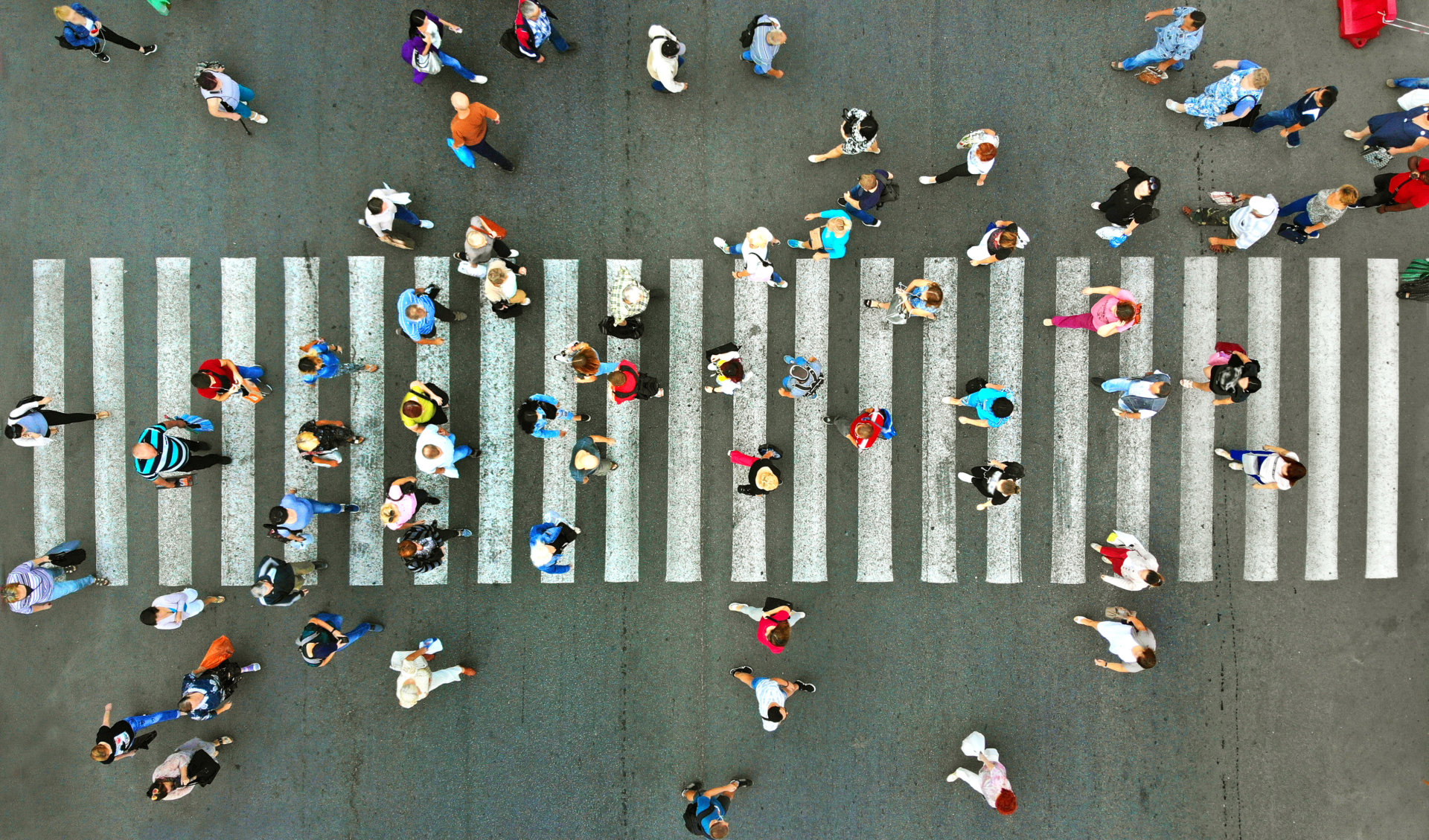
In recent years, digital technology has contributed to undeniable advances that have made life easier for everyone. At a time when this technology is at the heart of building new smart cities, what can be done to ensure that the situation of disabled people is alleviated and not aggravated? How can everyone’s specific needs be taken into consideration? In essence, how can a smart city be made inclusive?
We offer a reflection on this hugely strategic topic for the future!
What Is a Smart City?
A smart city is one that fully uses information and communications technology (ICT) to create an environment that can sustainably develop. This concept originates from the idea that digital technology can be used to improve the life of human beings. On a practical side, a smart city is basically based on a sensor network, connected objects and data management systems, which constantly collect and transmit information on the weather, air pollution, traffic flows, energy use and other factors. This data is then analyzed in real time, allowing local governments, businesses and even citizens to make informed decisions.
Many of the world’s cities and metropolises have taken steps in transitioning to becoming smarter, connected cities. Their approach is centered on areas such as air quality, traffic circulation, energy savings, full use of public spaces, ease of travel and active transport.
The creation of a smart city is simply a new way of conceiving the city. The use of digital technology is incorporated into the physical infrastructure so that residents and users receive the best service.
Disability as an Innovation Driver for the Smart City
New York City is even testing a more connected accessible pedestrian signal with aBeacon. Blind and visually impaired pedestrians can activate it with a remote control or a smartphone. They don’t have to press the pushbutton. This on demand and remote activation enables them to better locate the beginning of the crossing.
Plus, aBeacon can collect information regarding the number of users with visual impairments who have been activating it. This can be quite useful for all smart cities.
The first user testimonies are quite positive which makes this augmented accessible pedestrian signal a true innovation.
Singapore: the most intelligent city
Singapore is considered to be the most intelligent city and thus, the most accomplished example of a smart city in the world. Why? Thanks to the digitalization of the public services of the city-state, Singapore provides its citizens with a superior quality of life. Its goal? Smoothen everything to make their everyday lives easier.
But it goes beyond that by making its citizens actively participate in the creation and the improvement of the city’s services. For example, Singapore gave them access to an online design tool to conceive what one of the airport areas will look like. But the city-state also used data analysis from the social media of its citizens to map its cultural activities.
Singapore has perfectly understood what a smart city should be: to meet the needs of its citizens and to fully suit them, the city needs to be moulded according to their image. Consequently, even if technology is at the centre of the smart city, it remains managed, modified and controlled by humans.
How Could Disabled People Benefit from the Advances of a Smart City?
The cities involved in this transition generally perceive a smart city as a path towards a more environmentally friendly and human place to live. Looking at the number of projects by students, engineers and start-ups proposing technological solutions for disabled people, there is an obvious drive towards the construction of an inclusive smart city. Yet, real-life examples of such a noble idea remain few and far between. The solutions put forward are either based on a promising technology that still neglects the real needs and uses of those to whom it is directed, or are based on actual needs and uses but the solution’s sustainability is jeopardized because it lacks a viable economic model.
The way to enable disabled people to benefit from the advances of a smart city is to consider their specific needs from the very start of the projects. Just like physical accessibility for roadways and buildings, the cost for digital accessibility is almost minuscule when integrated into the design brief at the very beginning. Project stakeholders just need to be aware of this!
Let’s use the example of Singapore one more time: its public space is one of the most accessible places in the world. The same holds true for its public transport, its cultural venues such as museums and even for its sporting facilities that are adapted to parasports. Accessibility isn’t taken slightly by the city-state and neither is inclusion!
Singapore created “Enabling village”: a concept of experimentation focused on disability, accessibility and inclusion for people with disabilities. Based on universal design, this inclusive village strives to train and employ people with disabilities.
Overcoming Barriers to an Inclusive Smart City
According to a 2016 survey by Smart Cities for All, experts from around the world identified the lack of awareness about disability and accessibility in design and innovation as one of the main impediments to the “Smart City for All.”
On the other hand, the time users need to learn new technologies also represents a barrier. Elderly people, who often have a disability, are those who have the greatest trouble in adapting to new tools. Moreover, the free flow of data sometimes generates irrational fears. Therefore, education on these different solutions is an important matter.
As for the perspective of decision-makers, making way for innovation is not always possible. Large swathes of urban land are governed by specific rules and regulations. Meanwhile, the appropriation of public funds to experiment with new technology is generally seen as too risky. Such a decision can only arise from strong political will.
Finally, building an accessible or inclusive city needs to respect the continuity in the travel chain. For an inclusive smart city, we must also guarantee continuity in the information chain. The management of urban spaces is shared among many and varied public and private entities: municipalities, inter-municipalities, county, region, transportation operators, business, individuals, etc. A person in a wheelchair can’t enter an accessible building if the sidewalk doesn’t slope to the entrance: movement is impossible if the chain of information is broken.
The new services for the inhabitants and users of tomorrow will all be created from the same raw material: data. Far from being an exhaustible supply, as in the case of fossil fuels, the amount of data increases exponentially at 40% per year. The issue today is to make the data homogeneous, public and open, thereby allowing the creation of new services. Otherwise, such a colossal reserve cannot be tapped. Another issue directly linked to data relates to its life cycle. Data has to be made available in real time, and the data that becomes obsolete must be removed as soon as possible so the message doesn’t get distorted. Several technical committees focused on smart cities have already established different national and international standardization bodies.
Interested to know how New York City is turning into a Smart City? Read our article!
Keeping the Human Being at the Heart of the Initiative
If data represents the fuel and the smart city the vehicle, the destination is nothing more than facilitating the lives of people in all their diversity. To reach the goal of an inclusive smart city, it is essential to analyze the specific needs and uses of the inhabitants. Information should be provided in a way that is adapted to each person’s physical abilities and limitations. The selection of information must also correspond to these criteria and take into account the person’s situation.
When we think “smart,” we think “digital.” Yet, our towns and cities are real, impregnated with their own history, geography and ways of life. Connecting the digital world to the physical world, a concept known as “phygital,” is a key element in building smart cities that are truly inclusive. As it is today, the communication of information relating to the physical accessibility of places is cruelly lacking. Accessibility to information should go hand in hand with accessibility to places so that everyone has proper access to services. The decision-makers of cities should look at questions of physical accessibility simultaneously with digital accessibility.
The above shows that a smart city can be a marvelous opportunity to make society more inclusive. However, services need to be developed not just for the masses but also with due regard for the specific needs of minorities. Political will, financial resources, a desire for technological innovation and, most of all, experiments and feedback on usage are the essential ingredients for an inclusive smart city.
Are you already looking towards the future? Then, these articles are made for you:
Creating an Accessible and Barrier-Free Society Through Inclusive Design: a Constant Renewal
Updated on July 5th, 2022
media

If data represents the fuel and the smart city the vehicle, the destination is nothing more than facilitating the lives of people in all their diversity.
writer

Lise Wagner
Accessibility Expert
stay updated
Get the latest news about accessibility and the Smart City.
other articles for you

Open Data Is Key to Fostering Universal Accessibility
Open data represents an opportunity for cities to reach universal accessibility. It shows the missing links of the mobility chain.
Our Audio Beacons Guide the Blind and Visually Impaired at the Helsinki Subway
The Helsinky subway improved their audio signage system by installing on demand and remotely activated audio beacons.
7 Good Reasons to Install Audio Beacons at Your Public Transport Network
Audio beacons are an efficient way to provide more autonomy to blind and visually impaired people. They can easily use public transport.

Will Remote Activation Become the Norm for Accessible Pedestrian Signals?
More and more cities like New York have been exploring remote activation to trigger accessible pedestrian signals.
share our article!
more articles

Disability Statistics in the US: Looking Beyond Figures for an Accessible and Inclusive Society
Disability Statistics in the US: Looking Beyond Figures for an Accessible and Inclusive Society Around 61 million adults in the United States live with a disability. Diving into disability statistics in the US will help us know exactly who is concerned and what...
Our Audio Beacons Guide the Blind and Visually Impaired at the Helsinki Subway
Our Audio Beacons Guide the Blind and Visually Impaired at the Helsinki SubwayOur audio beacons equip the new line of the Helsinki subway in Finland. They help blind and visually impaired people locate the points of interest of a station. For users with visual...

Will Remote Activation Become the Norm for Accessible Pedestrian Signals?
Will Remote Activation Become the Norm for Accessible Pedestrian Signals?Without pushbutton, there are no accessible pedestrian signals. That’s how APS work in the U.S. But more and more cities have been exploring remote activation like New York City. The Department...

Hearing Impaired People: a Multitude of Profiles for Different Needs
Hearing Impaired People: a Multitude of Profiles for Different Needs Did you know that hearing impaired people have several profiles and that the way they identify themselves is important? You may be familiar with deaf and hard of hearing people but for each of...
NEVER miss the latest news about the Smart City.
Sign up now for our newsletter.
Unsubscribe in one click. The information collected is confidential and kept safe.
powered by okeenea
The French leading company
on the accessibility market.
For more than 25 years, we have been developing architectural access solutions for buildings and streets. Everyday, we rethink today’s cities to transform them in smart cities accessible to everyone.
By creating solutions ever more tailored to the needs of people with disabilities, we push the limits, constantly improve the urban life and make the cities more enjoyable for the growing majority.



